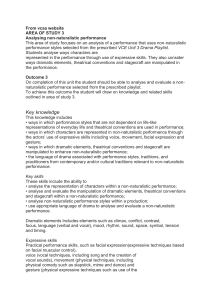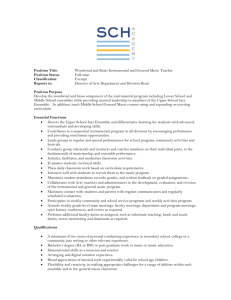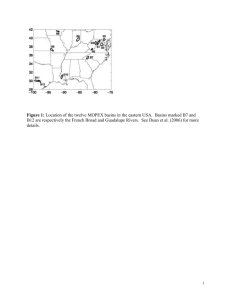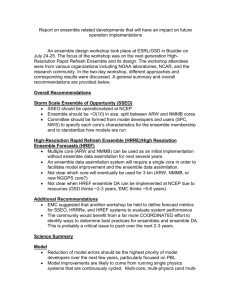Drama log Unit 3
advertisement
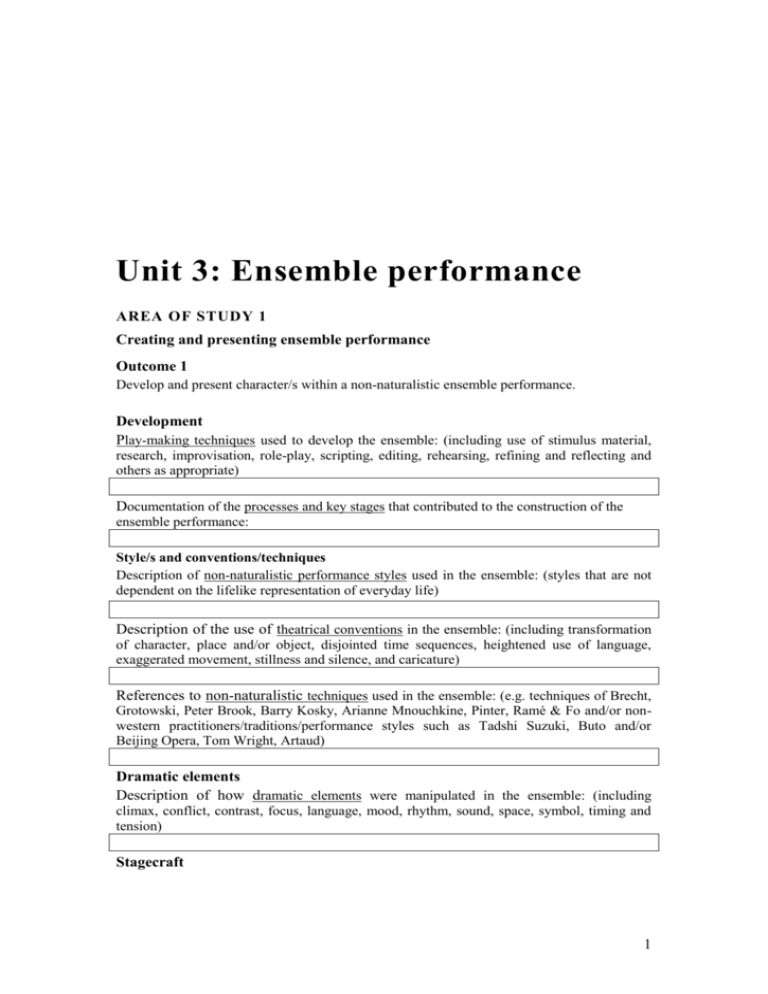
Unit 3: Ensemble performance AREA OF STUDY 1 Creating and presenting ensemble performance Outcome 1 Develop and present character/s within a non-naturalistic ensemble performance. Development Play-making techniques used to develop the ensemble: (including use of stimulus material, research, improvisation, role-play, scripting, editing, rehearsing, refining and reflecting and others as appropriate) Documentation of the processes and key stages that contributed to the construction of the ensemble performance: Style/s and conventions/techniques Description of non-naturalistic performance styles used in the ensemble: (styles that are not dependent on the lifelike representation of everyday life) Description of the use of theatrical conventions in the ensemble: (including transformation of character, place and/or object, disjointed time sequences, heightened use of language, exaggerated movement, stillness and silence, and caricature) References to non-naturalistic techniques used in the ensemble: (e.g. techniques of Brecht, Grotowski, Peter Brook, Barry Kosky, Arianne Mnouchkine, Pinter, Ramé & Fo and/or nonwestern practitioners/traditions/performance styles such as Tadshi Suzuki, Buto and/or Beijing Opera, Tom Wright, Artaud) Dramatic elements Description of how dramatic elements were manipulated in the ensemble: (including climax, conflict, contrast, focus, language, mood, rhythm, sound, space, symbol, timing and tension) Stagecraft 1 Description of the use of stagecraft to define and enhance the ensemble: (including: direction, costume, lighting, set design, sound production, make-up, mask, puppetry, props and theatre technologies such as multimedia projection) Expressive skills Expressive skills used to communicate in the ensemble performance: (including voice, movement, facial expressions and gesture) Collaboration Description of the collaborative processes used to develop/construct and present character/s for the ensemble performance: (such as negotiation, brainstorming, directing, research, improvisation, scripting, editing, rehearsing, refining and reflection) Performer and audience Description of how the relationship between the performer and audience was manipulated and explored: Research Research undertaken: experiences) (Internet, texts, audio-visual, interviews, observations, personal Bibliography: Visuals/Documents: (annotated, edited and sorted – not necessarily everything handed out in class or downloaded from the Internet) 2 AREA OF STUDY 2 Responding to the ensemble performance Outcome 2 Analyse play-making techniques used to construct and present ensemble works, including the work created for Outcome 1. Construction stages Describe, analyse and evaluate stages of the construction phase of the ensemble: (including research, improvisation, scripting, editing, rehearsing and refining) Presentation Describe, analyse and evaluate the presentation of the ensemble: Styles and conventions Ways performance styles and theatrical conventions were used in the development and presentation of the ensemble performance: Dramatic elements Ways dramatic elements were used in the development and presentation of the ensemble performance: Stagecraft Ways stagecraft was used in the development and presentation of the ensemble performance: Play-making techniques Ways play-making techniques were used in the development and presentation of the ensemble performance: Expressive skills Ways expressive skills were used in the development and presentation of the ensemble performance: Extended responses Describe, analyse and/or evaluate the stages of the construction phase of your ensemble, including research, improvisation, scripting, editing, rehearsing and refining. Describe, analyse and/or evaluate the presentation of your ensemble. Discuss ways theatrical conventions, performance styles, dramatic elements, stagecraft, playmaking techniques and/or expressive skills were used in the development and/or presentation of your ensemble. 3 AREA OF STUDY 3 Analysing non-naturalistic performance Outcome 3 Analyse and evaluate a non-naturalistic performance selected from the prescribed playlist. Name and description of the performance Styles and Conventions Ways in which non-naturalistic performance styles and theatrical conventions were used to enhance the performance: Expressive skills Ways in which characters were represented in performance through the actors’ use of expressive skills: (including voice, movement, facial expression and gesture - and especially through the use of non-naturalistic expressive techniques such as mime, song, dance, freeze, tableau, transformation, choreographed movement, physical exaggeration and vocal sound) Dramatic elements Ways in which dramatic elements were manipulated to enhance the performance: Stagecraft Ways in which stagecraft was manipulated to enhance the performance: Language My list of terms used to describe and analyse the performance: (language of drama that is associated with the performance styles, traditions, and practitioners from a range of contemporary and/or cultural traditions) Extended responses Analyse ways in which the characters were represented through non-naturalism. Analyse and/or evaluate the ways in which dramatic elements, theatrical conventions and/or stagecraft were manipulated through non-naturalism. Identify the non-naturalistic performance styles and conventions used in the performance. 4
